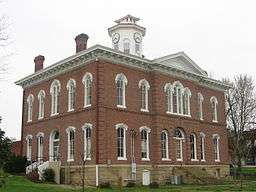Vienna, Illinois
| Vienna | |
| City | |
 Johnson County Courthouse, downtown | |
| Country | United States |
|---|---|
| State | Illinois |
| County | Johnson |
| Elevation | 404 ft (123 m) |
| Coordinates | 37°24′58″N 88°53′39″W / 37.41611°N 88.89417°WCoordinates: 37°24′58″N 88°53′39″W / 37.41611°N 88.89417°W |
| Area | 2.88 sq mi (7 km2) |
| - land | 2.84 sq mi (7 km2) |
| - water | 0.04 sq mi (0 km2) |
| Population | 1,434 (2010) |
| Density | 550.8/sq mi (213/km2) |
| Mayor | Jon Simmons |
| Timezone | CST (UTC-6) |
| - summer (DST) | CDT (UTC-5) |
| Postal code | 62995 |
| Area code | 618 |
  Location of Vienna within Illinois | |
| Wikimedia Commons: Vienna, Illinois | |
- For the Illinois village formerly known as Vienna, see Astoria, Illinois
Vienna ![]() i/vaɪˈænə/ is a city in Johnson County, Illinois, United States. The population was 1,434 at the 2010 census. It is the county seat of Johnson County[1] and the site of two well-known state penitentiaries.
i/vaɪˈænə/ is a city in Johnson County, Illinois, United States. The population was 1,434 at the 2010 census. It is the county seat of Johnson County[1] and the site of two well-known state penitentiaries.
The town's name is pronounced differently, by most people, from the English name for the Austrian capital of the same name.
Notable locations
Heron Pond - Little Black Slough Nature Preserve, a National Natural Landmark, is nearby.
The Tunnel Hill State Trail trail-head and headquarters is located in Vienna.
The Trail of Tears halfway point commemorative totem and flags are located in the adjacent city park.
Vienna is home to the Johnson County Courthouse, which is on the National Register of Historic Places. This courthouse is the oldest still-working courthouse to date. Court hearings have been held here longer than any courthouse in the entire state. The Vienna Public Library, across the street from the courthouse, is also listed on the National Register.
Dixon Springs State Park is located nearby in Dixon Springs, which is about 15 minutes from downtown Vienna.
The Garden of the Gods Wilderness is located a short distance east of Vienna, offering hikers a place to hike locally.
Education
The city, which has about 700 students within its two districts, is home to Vienna Grade School and Vienna High School. Located nearby are Shawnee Community College in Ullin and Southern Illinois University Carbondale in Carbondale, which both act as a local college for students of the geographical area.
Transportation
Although Vienna is not served by an airport or train station, bus service runs through the city twice daily. Greyhound Bus service to Vienna runs daily to the local Hospitality House and Greyhound Bus Station downtown.
Major highways
 I-24
I-24 US 45
US 45 Illinois Route 146 crosses at the major intersection downtown with U.S. 45.
Illinois Route 146 crosses at the major intersection downtown with U.S. 45. Illinois Route 147
Illinois Route 147 Illinois Route 37
Illinois Route 37 Illinois Route 145
Illinois Route 145
Bicycling
Vienna is considered by some to be the bicycling capitol of the Midwestern USA. Most people who live in the area bicycle weekly on the many trails and bike routes within the city. A bike path that runs from Vienna High School to Vienna Trail of Tears City Park was completed in August 2014, and allows visitors to commute between Northern Vienna and the Tunnel Hill State Trail.
U.S. Bicycle Route 76 crosses with Tunnel Hill State Trail in Vienna.
Tunnel Hill State Trail's Headquarters is in Vienna, and an entire facility equipped with restrooms and vending machines is located within the headquarters, as well as a bicycling museum.
Geography
Vienna is located at 37°24′58″N 88°53′39″W / 37.41611°N 88.89417°W (37.416103, -88.894268).[2]
According to the 2010 census, Vienna has a total area of 2.887 square miles (7.48 km2), of which 2.85 square miles (7.38 km2) (or 98.72%) is land and 0.037 square miles (0.10 km2) (or 1.28%) is water.[3]
Demographics
| Historical population | |||
|---|---|---|---|
| Census | Pop. | %± | |
| 1850 | 142 | — | |
| 1870 | 550 | — | |
| 1880 | 494 | −10.2% | |
| 1890 | 828 | 67.6% | |
| 1900 | 1,217 | 47.0% | |
| 1910 | 1,124 | −7.6% | |
| 1920 | 907 | −19.3% | |
| 1930 | 874 | −3.6% | |
| 1940 | 1,173 | 34.2% | |
| 1950 | 1,085 | −7.5% | |
| 1960 | 1,094 | 0.8% | |
| 1970 | 1,325 | 21.1% | |
| 1980 | 1,420 | 7.2% | |
| 1990 | 1,446 | 1.8% | |
| 2000 | 1,234 | −14.7% | |
| 2010 | 1,434 | 16.2% | |
| Est. 2015 | 1,647 | [4] | 14.9% |
As of the census[6] of 2000, there were 1,234 people, 560 households, and 309 families residing in the city. The population density was 550.8 people per square mile (212.7/km²). There were 607 housing units at an average density of 270.9 per square mile (104.6/km²). The racial makeup of the city was 97.89% White, 0.08% African American, 0.08% Asian, 0.81% from other races, and 1.13% from two or more races. Hispanic or Latino of any race were 1.94% of the population.
There were 560 households out of which 27.7% had children under the age of 18 living with them, 39.5% were married couples living together, 13.2% had a female householder with no husband present, and 44.8% were non-families. 41.4% of all households were made up of individuals and 25.5% had someone living alone who was 65 years of age or older. The average household size was 2.12 and the average family size was 2.89.
In the city the population was spread out with 22.6% under the age of 18, 9.0% from 18 to 24, 23.8% from 25 to 44, 18.3% from 45 to 64, and 26.3% who were 65 years of age or older. The median age was 40 years. For every 100 females there were 77.0 males. For every 100 females age 18 and over, there were 70.8 males.
The median income for a household in the city was $21,702, and the median income for a family was $31,250. Males had a median income of $34,583 versus $17,614 for females. The per capita income for the city was $13,662. About 17.7% of families and 20.0% of the population were below the poverty line, including 27.0% of those under age 18 and 21.4% of those age 65 or over.
Notable people
- Pleasant T. Chapman, congressman, born nearby and practiced law here
- George W. English, United States District Court judge, born nearby, practiced law here, was impeached in 1926
- William Heirens, reputed serial-killer, spent 23 years at the Vienna Correctional Center
- Andrew J. Kuykendall, congressman, practiced law here
- Adrian Lindsey, American football coach
- William W. Mitchell, Sr., Arizona legislator, born here
- Paul Powell, former Illinois Secretary of State, born here
References
- ↑ "Find a County". National Association of Counties. Retrieved 2011-06-07.
- ↑ "US Gazetteer files: 2010, 2000, and 1990". United States Census Bureau. 2011-02-12. Retrieved 2011-04-23.
- ↑ "G001 - Geographic Identifiers - 2010 Census Summary File 1". United States Census Bureau. Retrieved 2015-12-27.
- ↑ "Annual Estimates of the Resident Population for Incorporated Places: April 1, 2010 to July 1, 2015". Retrieved July 2, 2016.
- ↑ "Census of Population and Housing". Census.gov. Retrieved June 4, 2015.
- ↑ "American FactFinder". United States Census Bureau. Retrieved 2008-01-31.